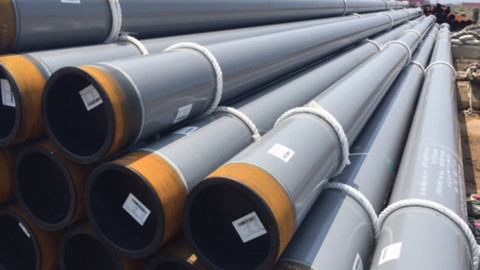by Danielle Roche
After almost five years of development, a new international standard for asset management has been released, providing a mechanism to deal with a number of the challenges facing utilities in Australia today.
The arrival of the new international standard for asset management comes at a good time for the utilities industry in Australia. Currently, there is a lot of duplication in our industry, and organisations are spending money doing the same thing – solving the same asset management problems that others have already solved. We are trying to measure our asset management performance against each other to identify areas of improvement and show that we are good asset managers. Our regulators are increasingly focused on the cost of maintaining our existing assets and of building new ones, and we must justify every dollar of expenditure. We need to be able to clearly demonstrate the trade-offs we make in managing asset risk, cost and outcomes and how we make them. And we must now, more than ever, show how what we do in asset management helps achieve the corporate objectives of our organisations.
Since 2004, many asset managers have used the Publicly Available Specification number 55 (PAS55) to help address some of these issues. Developed by the Institute of Asset Management in the UK and published by the British Standards Institute, PAS55 has been considered to be the best infrastructure asset management standard available. However, in 2009 the authors of PAS55 proposed that it be used as the basis for the development of a new international standard, and a meeting of representatives from countries including Australia, the UK, Canada, Finland, the Netherlands, Japan, Portugal and Germany agreed unanimously. Given the number 55000 as recognition for PAS55, the long process of writing the new International Organisation for Standardisation (ISO) standard began.
Through Standards Australia a team was formed to represent Australia in the standards development process. With members from roads, mining, energy, water, defence and local government amongst others, the focus on representatives having a practitioner background proved to be an important distinction the Australian team had over many other countries involved in the process. The team also remained essentially constant for the entire five-year process and is still in place today.
Between 2009 and 2013 the Australian group met with the international team working on ISO 55000 in locations as diverse as Washington D.C., Pretoria, London, Prague and Melbourne and as many as 31 countries participated in the process. During that time what started out as ISO 55000 became three documents:
ISO 55000 Asset Management: Overview, principles and terminology
This document sets the scene for the other document and outlines the principles, terms and definitions used across the three documents. It is the document that provides a good summary of the standards for senior management.
ISO 55001 Asset Management: Management System – Requirements
ISO 55001 is the document that advises on the requirements to comply with the standard, and is the document that the auditor will focus on for companies seeking certification with the standard.
ISO 55002 Asset Management: Management Systems – Guidelines on the application of ISO 55001
ISO 55002 provides guidance on implementing 55001. It is not a detailed guidance document and provides reference to other existing guidance documents like the IPWEA’s International Infrastructure Management Manual.
For those familiar with PAS55, many of the concepts of this standard are retained in the new ISO 55000 family of standards, including:
• Alignment of the organisational and asset management objectives;
• A whole-of-asset life cycle approach;
• Risk-based asset management;
• Enablers including leadership, communication and information management.
However there are a number of areas where the ISO 55000 family of standards moves away from PAS55, including:
• The standard can be applied to any type of asset (not just infrastructure).
• The terminology has been simplified and generalised.
• There is more focus on leadership and context.
• The standards are very clearly for an asset management system, not for asset management.
• The term asset management strategy is no longer used, it is now called a Strategic Asset Management Plan.
• There is less risk management detail but linkage and reference to the ISO Risk Management Standard.
• The document structure is in line with ISO management systems standard requirements.
Apart from the content of the documents, the ISO 55000 family of standards provides a mechanism to deal with a number of the challenges facing utilities in Australia today.
It provides a common language that can be used to share information and collaborate in the utility industry and with other sections to reduce duplication in the management of assets, and move asset management within the industry forward. It can also support benchmarking within and across industries, and provide the basis for the development of cross-industry training and development and enable the easy transfer of skills across sectors.
Being management system standards, like some of the highest profile ISO standards – including ISO 14000 Environmental Management and ISO 9000 Quality Management – the standards are likely to increase the profile of asset management in organisations and with regulators and stakeholders. The likelihood of companies advertising their compliance with the ISO 55000 family in the same way as they do for quality, safety and environmental standards should not be underestimated. Equally the use of this standard as hurdle criteria for suppliers of asset management related services is to be expected.
Along with the benefits of the new standards there are some risks to be considered. Already the standard has been included in regulatory requirements of a utility organisation in Australia. It was a key design criterion in the ISO 55000 family that the organisation could determine the depth to which the components of the standard were relevant to the asset management objectives of the organisation and hence needed to be applied. Forced regulation may compromise this approach and result in wasted resources and inappropriate asset management systems.
Another risk associated with the standards is over-reliance. As with any standard the ISO 55000 family is designed to be informative, but the premise that use of the standards equals good asset management or asset management outcomes is not necessarily true. There are many other components of good asset management, and whilst the ISO 55000 family of standards should identify many of them it is not the only piece of the puzzle.
Perhaps the biggest risk is that implementing the ISO 55000 family of standards is seen as a quick fix to asset management issues. Another fundamental tenet of the standards is that good asset management practice is considered to be an ongoing, continuous improvement journey. There is no quick and easy approach to fixing asset management challenges or solving problems. Application of the standards is also very specific to the organisation and the context within which it operates, and cannot be a cut and paste of another organisation’s application.
In dealing with these opportunities and risks there are a few things to consider before an organisation commences the adoption of the ISO 55000 family of standards:
• Is the need for an asset management system recognised by the organisation?
• Do you have senior management commitment to the adoption of the ISO 55000 family, including required time, resources and support?
• Does the organisation have clear organisational objectives that can be used to develop or link to asset management objectives?
• Do you have a long-term, continuous improvement approach to the implementation of the ISO 55000 family?
If the answer to those four questions is yes then the application of the ISO 55000 family of standards within the organisation is off to a good start. There are many sources of information available now and in development to assist in the application of the standards, including tools to undertake a gap analysis of your current asset management system compared to ISO 55001 requirements.
For asset management within the utilities industry, the arrival of the ISO 55000 standards is the beginning of a new journey. It will be interesting to observe the application of the standards and their development in the future, and the extent to which the industry takes up the opportunity to work together to get leverage from the ISO 55000 standards to improve asset management practices across the sector.
Danielle Roche is the Director of the Red Wire Consulting Group, a future-focused business management consulting service. Danielle has a wealth of experience in asset management, particularly in the water sector, having previously held the position of Manager Asset Management at both the Water Services Association of Australia and City West Water. Danielle can be contacted at [email protected] or 0411 016 444.














